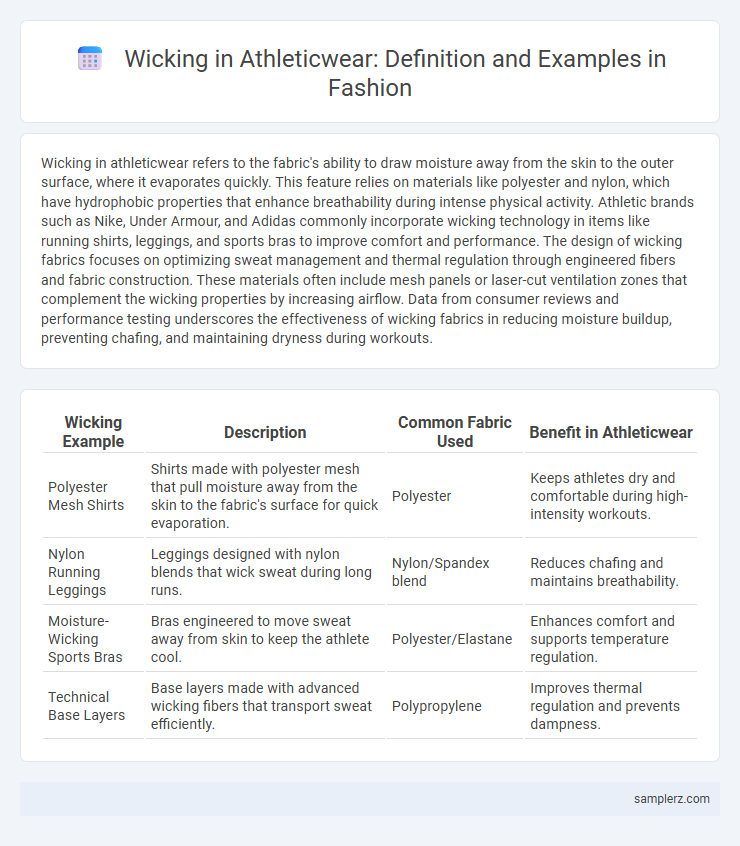Wicking in athleticwear refers to the fabric's ability to draw moisture away from the skin to the outer surface, where it evaporates quickly. This feature relies on materials like polyester and nylon, which have hydrophobic properties that enhance breathability during intense physical activity. Athletic brands such as Nike, Under Armour, and Adidas commonly incorporate wicking technology in items like running shirts, leggings, and sports bras to improve comfort and performance. The design of wicking fabrics focuses on optimizing sweat management and thermal regulation through engineered fibers and fabric construction. These materials often include mesh panels or laser-cut ventilation zones that complement the wicking properties by increasing airflow. Data from consumer reviews and performance testing underscores the effectiveness of wicking fabrics in reducing moisture buildup, preventing chafing, and maintaining dryness during workouts.
Table of Comparison
| Wicking Example | Description | Common Fabric Used | Benefit in Athleticwear |
|---|---|---|---|
| Polyester Mesh Shirts | Shirts made with polyester mesh that pull moisture away from the skin to the fabric's surface for quick evaporation. | Polyester | Keeps athletes dry and comfortable during high-intensity workouts. |
| Nylon Running Leggings | Leggings designed with nylon blends that wick sweat during long runs. | Nylon/Spandex blend | Reduces chafing and maintains breathability. |
| Moisture-Wicking Sports Bras | Bras engineered to move sweat away from skin to keep the athlete cool. | Polyester/Elastane | Enhances comfort and supports temperature regulation. |
| Technical Base Layers | Base layers made with advanced wicking fibers that transport sweat efficiently. | Polypropylene | Improves thermal regulation and prevents dampness. |
What Is Moisture-Wicking in Athleticwear?
Moisture-wicking in athleticwear refers to the fabric's ability to draw sweat away from the skin to the garment's outer surface, where it can evaporate quickly. High-performance materials like polyester, nylon, and specialized blends such as Coolmax and Dri-FIT are engineered to enhance breathability and keep athletes dry and comfortable during intense physical activity. This technology reduces discomfort and helps regulate body temperature, improving overall athletic performance and recovery.
How Wicking Technology Works in Sports Apparel
Wicking technology in sports apparel uses specialized synthetic fibers like polyester or nylon to draw moisture away from the skin to the fabric's outer surface, where it can evaporate quickly. This process helps regulate body temperature and maintain dryness during intense physical activity, enhancing comfort and performance. Athleticwear brands such as Nike Dri-FIT and Adidas Climalite utilize microfibers engineered to maximize airflow and moisture dispersion.
Best Fabrics for Wicking in Athleticwear
Polyester and nylon are among the best fabrics for wicking in athleticwear due to their ability to efficiently draw moisture away from the skin, keeping athletes dry and comfortable. Merino wool offers natural moisture-wicking properties combined with breathability and odor resistance, making it ideal for intense workouts. Blends incorporating spandex enhance stretch and fit while maintaining effective moisture management essential for high-performance athleticwear.
Top Examples of Wicking Athletic Clothing
Top examples of wicking athletic clothing include Nike Dri-FIT shirts, Under Armour HeatGear tops, and Adidas Climalite apparel, all designed with moisture-wicking technology to keep athletes dry and comfortable. These garments use advanced polyester blends and mesh panels that promote airflow and rapid sweat evaporation during intense workouts. High-performance wicking fabrics enhance temperature regulation, reduce chafing, and improve overall athletic endurance.
Benefits of Wicking Materials for Active Lifestyles
Wicking materials in athleticwear, such as polyester and nylon blends, efficiently draw sweat away from the skin to the fabric's surface, promoting rapid evaporation and enhanced breathability. These fabrics help regulate body temperature during high-intensity workouts, reducing discomfort and the risk of chafing or skin irritation. By maintaining dryness, wicking athleticwear improves overall performance and endurance for active lifestyles.
Wicking versus Non-Wicking Sportswear: Key Differences
Wicking athleticwear, made from synthetic fibers like polyester and nylon, effectively draws moisture away from the skin to keep athletes dry and comfortable during intense workouts. Non-wicking sportswear, often made of cotton, absorbs sweat but retains it, leading to dampness and potential chafing. Choosing wicking fabrics enhances performance by regulating temperature and reducing irritation compared to non-wicking materials.
Popular Brands Using Wicking Technology
Nike incorporates advanced Dri-FIT technology in its athleticwear, efficiently wicking sweat away from the skin to enhance comfort during intense workouts. Under Armour's HeatGear fabric utilizes moisture-wicking properties designed to keep athletes cool and dry under extreme conditions. Adidas integrates Climalite fabric to ensure effective sweat evaporation, promoting breathable performance wear for active lifestyles.
Wicking Performance in Running Shirts and Shorts
Running shirts and shorts with advanced wicking technology use hydrophobic fabrics such as polyester and nylon to efficiently draw sweat away from the skin, enhancing comfort and preventing chafing during high-intensity workouts. Brands like Nike Dri-FIT and Under Armour HeatGear incorporate microfibers designed to accelerate moisture evaporation, maintaining optimal body temperature. Wicking performance in these garments directly impacts athletic endurance by reducing moisture buildup and improving breathability in every stride.
Innovations in Wicking Athleticwear Fabrics
Innovations in wicking athleticwear fabrics include the integration of moisture-wicking fibers such as polyester blends and specialized yarns like polypropylene that efficiently pull sweat away from the skin. Advanced technologies like micro-porous membranes and hydrophobic coatings enhance breathability and quick-drying properties, improving overall comfort during high-intensity workouts. Brands such as Nike Dri-FIT and Under Armour HeatGear utilize these innovations to optimize performance and moisture management in athletic apparel.
Tips for Caring for Wicking Athleticwear
To maintain the moisture-wicking properties of athleticwear, wash garments in cold water with mild detergent and avoid fabric softeners as they can clog the fabric's pores. Hang dry or lay flat to preserve the elasticity and breathability of synthetic fibers like polyester and nylon commonly used in wicking fabrics. Store athleticwear in a cool, dry place to prevent odor buildup and prolong the lifespan of moisture-wicking technology.

example of wicking in athleticwear Infographic
 samplerz.com
samplerz.com